Plot
The appearance of an unknown "missile-like" object in nearby space leads a European nation (unnamed, but implied to be one of the countries behind the Iron Curtain) to fire a rocket at it. Though the rocket intercepts the unidentified object, the explosion only diverts the missile into an orbit around the Earth. Racing five miles above the earth, tremendous heat from its rocket engine causes widespread devastation of the land below.
Meanwhile, at the Havenbrook Atomic Laboratory (a thinly veiled reference to the Brookhaven National Laboratory) in suburban New York City, Dr. David Loring and his assistant Joan Woods are preparing for their wedding later that day. Though both are in love, David is deeply committed to his work on a hydrogen warhead for the new "Jove" rocket, so much so that it has interfered with previous attempts at a wedding. Leaving work to go ring shopping, David's irritation with time spent on it leads Joan to accuse him of prioritizing work over their relationship, and she calls off the marriage.
With the missile blazing its path of destruction, a radar station on the DEW Line picks up its approach to the North American continent. Though a patrol jet diverted to intercept the missile is destroyed by the intense heat of its drive, the pilot captures a picture of it that is then transmitted to "Conad", Continental Air Defense Command. An alert mobilizes jets from the Royal Canadian Air Force, which are unable to shoot it down and are destroyed in the attempt.
With the missile projected to fly over New York City, the U.S. military orders a full mobilization. The U.S. and Canadian authorities implement civil defense procedures, preparing the cities of New York and Ottawa for the imminent passage of the missile. As Havenbrook is being evacuated, David realizes that he can use the Jove rocket to get through the missile's intense heat to destroy it, using the fission bomb "trigger" from the incomplete hydrogen warhead. While he works to prepare the plutonium for the bomb, the government orders a full evacuation of New York City. Further efforts by conventional forces to destroy the missile prove unsuccessful, and Ottawa is destroyed as it flies overhead.
As David and Joan race the nuclear core to the missile base, they are attacked by a group of young thugs who steal their jeep with the core inside. David and Joan chase after them, only to find the jeep alongside the road and the men dead from radiation poisoning after having opened the lead-lined box with the plutonium core. Knowing that exposure is fatal, David grabs the box and drives the core to the waiting rocket, loading it into the warhead before dying. The rocket is then launched, intercepting the missile over Lake Champlain and destroying it. The final seconds show scenes of New York City streets, including a movie marquee advertising 1951's Two Tickets to Broadway .
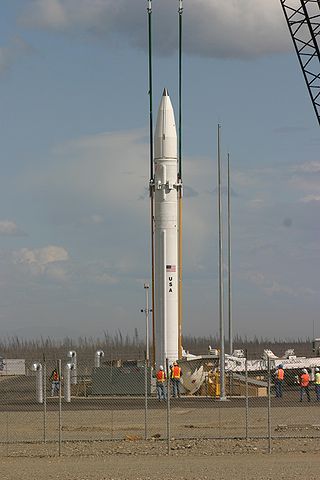
An anti-ballistic missile (ABM) is a surface-to-air missile designed to counter ballistic missiles. Ballistic missiles are used to deliver nuclear, chemical, biological, or conventional warheads in a ballistic flight trajectory. The term "anti-ballistic missile" is a generic term conveying a system designed to intercept and destroy any type of ballistic threat; however, it is commonly used for systems specifically designed to counter intercontinental ballistic missiles (ICBMs).
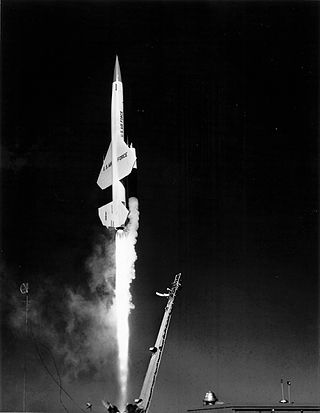
The Boeing CIM-10 Bomarc was a supersonic ramjet powered long-range surface-to-air missile (SAM) used during the Cold War for the air defense of North America. In addition to being the first operational long-range SAM and the first operational pulse doppler aviation radar, it was the only SAM deployed by the United States Air Force.

An intercontinental ballistic missile (ICBM) is a ballistic missile with a range greater than 5,500 kilometres (3,400 mi), primarily designed for nuclear weapons delivery. Conventional, chemical, and biological weapons can also be delivered with varying effectiveness, but have never been deployed on ICBMs. Most modern designs support multiple independently targetable reentry vehicle (MIRVs), allowing a single missile to carry several warheads, each of which can strike a different target. The United States, Russia, China, France, India, the United Kingdom, Israel, and North Korea are the only countries known to have operational ICBMs.

A nuclear weapon is an explosive device that derives its destructive force from nuclear reactions, either fission or a combination of fission and fusion reactions, producing a nuclear explosion. Both bomb types release large quantities of energy from relatively small amounts of matter.
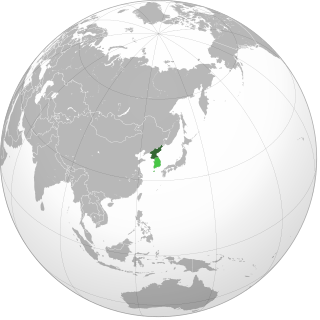
North Korea has a military nuclear weapons program and, as of early 2020, is estimated to have an arsenal of approximately 30 to 40 nuclear weapons and sufficient production of fissile material for six to seven nuclear weapons per year. North Korea has also stockpiled a significant quantity of chemical and biological weapons. In 2003, North Korea withdrew from the Treaty on the Non-Proliferation of Nuclear Weapons (NPT). Since 2006, the country has conducted six nuclear tests at increasing levels of expertise, prompting the imposition of sanctions.

Nuclear weapon designs are physical, chemical, and engineering arrangements that cause the physics package of a nuclear weapon to detonate. There are three existing basic design types:

Building on major scientific breakthroughs made during the 1930s, the United Kingdom began the world's first nuclear weapons research project, codenamed Tube Alloys, in 1941, during World War II. The United States, in collaboration with the United Kingdom, initiated the Manhattan Project the following year to build a weapon using nuclear fission. The project also involved Canada. In August 1945, the atomic bombings of Hiroshima and Nagasaki were conducted by the United States, with British consent, against Japan at the close of that war, standing to date as the only use of nuclear weapons in hostilities.

The nuclear arms race was an arms race competition for supremacy in nuclear warfare between the United States, the Soviet Union, and their respective allies during the Cold War. During this same period, in addition to the American and Soviet nuclear stockpiles, other countries developed nuclear weapons, though none engaged in warhead production on nearly the same scale as the two superpowers.

Canada has not officially maintained and possessed weapons of mass destruction since 1984 and, as of 1998, has signed treaties repudiating possession of them. Canada ratified the Geneva Protocol in 1930 and the Nuclear Non-proliferation Treaty in 1970.

The W25 was a small nuclear warhead that was developed by the Los Alamos Scientific Laboratory for air-defense use. It was a fission device with a nominal yield of 1.7 kt.

Missile defense is a system, weapon, or technology involved in the detection, tracking, interception, and also the destruction of attacking missiles. Conceived as a defense against nuclear-armed intercontinental ballistic missiles (ICBMs), its application has broadened to include shorter-ranged non-nuclear tactical and theater missiles.

The United States was the first country to manufacture nuclear weapons and is the only country to have used them in combat, with the bombings of Hiroshima and Nagasaki in World War II. Before and during the Cold War, it conducted 1,054 nuclear tests, and tested many long-range nuclear weapons delivery systems.

A thermonuclear weapon, fusion weapon or hydrogen bomb (H bomb) is a second-generation nuclear weapon design. Its greater sophistication affords it vastly greater destructive power than first-generation nuclear bombs, a more compact size, a lower mass, or a combination of these benefits. Characteristics of nuclear fusion reactions make possible the use of non-fissile depleted uranium as the weapon's main fuel, thus allowing more efficient use of scarce fissile material such as uranium-235 or plutonium-239. The first full-scale thermonuclear test was carried out by the United States in 1952; the concept has since been employed by most of the world's nuclear powers in the design of their weapons.

Nuclear weapons delivery is the technology and systems used to place a nuclear weapon at the position of detonation, on or near its target. Several methods have been developed to carry out this task.
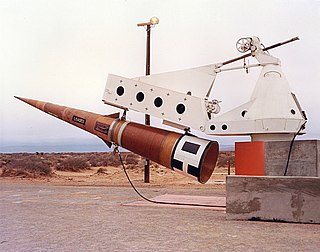
The Sprint was a two-stage, solid-fuel anti-ballistic missile (ABM), armed with a W66 enhanced-radiation thermonuclear warhead used by the United States Army during 1975–76. It was designed to intercept incoming reentry vehicles (RV) after they had descended below an altitude of about 60 kilometres (37 mi), where the thickening air stripped away any decoys or radar reflectors and exposed the RV to observation by radar. As the RV would be traveling at about 5 miles per second, Sprint needed to have phenomenal performance to achieve an interception in the few seconds before the RV reached its target.

The RIM-161 Standard Missile 3 (SM-3) is a ship-based surface-to-air missile system used by the United States Navy to intercept short- and intermediate-range ballistic missiles as a part of Aegis Ballistic Missile Defense System. Although primarily designed as an anti-ballistic missile, the SM-3 has also been employed in an anti-satellite capacity against a satellite at the lower end of low Earth orbit. The SM-3 is primarily used and tested by the United States Navy and also operated by the Japan Maritime Self-Defense Force.
This timeline of nuclear weapons development is a chronological catalog of the evolution of nuclear weapons rooting from the development of the science surrounding nuclear fission and nuclear fusion. In addition to the scientific advancements, this timeline also includes several political events relating to the development of nuclear weapons. The availability of intelligence on recent advancements in nuclear weapons of several major countries is limited because of the classification of technical knowledge of nuclear weapons development.
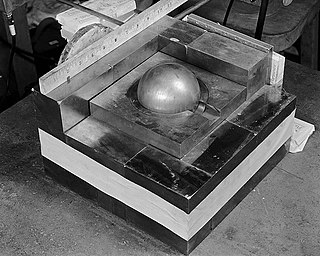
In nuclear weapon design, the pit is the core of an implosion nuclear weapon, consisting of fissile material and any neutron reflector or tamper bonded to it. Some weapons tested during the 1950s used pits made with uranium-235 alone, or as a composite with plutonium. All-plutonium pits are the smallest in diameter and have been the standard since the early 1960s. The pit is named after the hard core found in stonefruit such as peaches and apricots.
A ballistic missile goes through several distinct phases of flight that are common to almost all such designs. They are, in order:

















